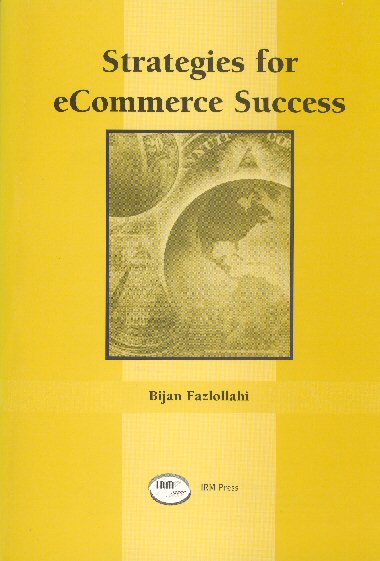| Foreword Bijan Fazlollahi, Georgia State University |
i |
| Preface |
v |
| Chapter 1. Cyber Shopping and Privacy Jatinder N. D. Gupta and Sushil K. Sharma, Ball State University, USA |
1 |
| Chapter 2. Structural Influences on Global E-Commerce Activity M.Lynne Markus, City University of Hong Kong, China - Christina Soh, Nanyang Technological University, Singapore |
17 |
| Chapter 3. Social Issues in Electronic Commerce: Implications for Policy Makers Anastasia Papazafeiropoulou and Athanasia Pouloudi, Brunel University, United Kingdom |
32 |
| Chapter 4. Identifying Motivations for the Use of Commercial Web Sites Thomas F. Stafford, Texas Women's University, USA - Marla Royne Stafford, University of North Texas, USA |
50 |
| Chapter 5. Signalling Intentions and Obliging Behavior Online: An Application of Semiotic and Legal Modeling in E-Commerce James Backhouse, London School of Economics, United Kingdom - Edward K. Cheng, Harvard Law School, USA |
68 |
| Chapter 6. Customer Loyalty and Electronic Banking: A Conceptual Framework Daniel Tomiuk and Alain Pinsonneault, McGill University, Canada |
89 |
| Chapter 7. Electronic Commerce and Strategic ChangeWithin Organizations: Lessons from Two Cases Robert D. Galliers, London School of Economics, United Kingdom - Sue Newell, University ofLondon, United Kingdom |
110 |
| Chapter 8. Trustininternet Shopping: instrument Development and Validation Through Classical and Modern Approaches Christy M. K. Cheung and Matthew K. 0., Lee City University of Hong Kong, China |
126 |
| Chapter 9. Electronic Broker Impacts on theValue ofPostponementin a Global Supply Chain William N. Robinson, Georgia State University, USA - Greg Elofsen, Fordham University, USA |
146 |
| Chapter 10. Internal Audit of Inter-Based Electronic Commerce Transactions: A TQMApproach Haider H. Madani, King Fahd University of Petroleum and Minerals, Saudi Arabia |
177 |
|
|
| Chapter 11. Electronic Commerce Acceptance: A Study Comparing the United States and the United Kingdom Donna W McCloskey, Widener University, USA - David Whiteley, Manchester Metropolitan University, United Kingdom |
185 |
| Chapter 12. Intelligent Software Agents in Electronic Commerce: A Socio-technical Perspective Mahesh S. Raisinghani, University of Dallas, USA - Chris Klassen, The Software Construction Company, USA - Lawrence L. Schkade, University of Texas at Arlington, USA |
196 |
| Chapter 13. Impacts of Software Agents in eCommerce Systems on Customer's Loyalty and on Behavior of Potential Customers Juergen Seitz, Berufsakademie Heidenheim, Germany - Eberhard Stickel and Krzysztof Woda, European University, Germany |
208 |
| Chapter 14. Internet Payment Mechanisms: Acceptance and Control Issues Uhlc J. Gelinas, Jr and Janis L. Gogan, Bentley College, USA |
224 |
| Chapter 15. Approaches to a Decentralized Architecture for an Electronic Market - A Study for the Air Cargo Business Freimut Bodendorf and Stefan Reinheimer, University of Erlangen-Nuremberg, Germany |
236 |
| Chapter 16. A Web Usability Assessment Model and Automated Toolset Shirley A. Becker, Anthony H. Berkemeyer and Natalie A. Roberts, Florida Institute of Technology, USA |
251 |
| Chapter 17. Categorizing the Supplier Content of Public Web Sites Dale Young, Miami University-Ohio, USA |
261 |
| Chapter 18. Multi-Dimensional 13211 Auctions for Electronic Commerce Marilyn T Griffin and France Bellanger, Virginia Polytechnic Institute and State University, USA - Craig Van Slyke, University of Central Florida, USA |
271 |
| Chapter 19. Mobile Agents, Mobile Computing and MobileUsersin Global E-Commerce Roberto Vinaia, University of Texas Pan American, USA |
278 |
| Chapter 20. Evaluation of Electronic Commerce Adoption within SMEs Marco Tagliavini, Aurelio Ravarini and Alessandro Antonelli Università Cattaneo, Italy |
289 |
| Chapter 21. The Cost ofEmail within Organizations Thomas W Jackson and Ray Dawson, Loughborough University, United Kingdom - Darren Wilson, The Danwood Group, United Kingdom |
307 |
| Chapter 22. Electronic Commerce: Determining 112C Web site Functions Bijan Fazlollahi, Georgia State University, USA |
314 |
| About the Editor |
329 |
| Index |
330 |
|


